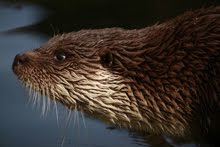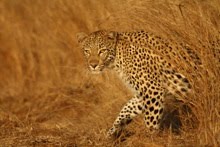Zoos can provide a great place to practice your digiscoping techniques as it provides you with countless opportunities to get close to more people-accustomed animals. They tend to sit still for longer, move slower, and not be as far away as in a wild situation. But zoos also provide a number of challenges in getting decent photos.
Wire as a background
Because one is in an unnatural setting, it is very easy for the image to look like it was taken in an unnatural setting. Despite the natural rocks in the Northern Wheatear image, above, the wire background destroys the image. The trick is to:
- minimize the distance between you and the bird
- maximize the amount of space between the bird and the wire fence, and
- reduce the depth of field by using the largest aperture possible (smallest f number). This will also give you the fastest shutter speed, which is very useful when digiscoping birds.
If you manage to get the photographic subject in a good position, don't be shy to snap off lots of photos and to play with the settings to create an acceptable image. In the second digiscoped photo of the northern wheatear, above, the bird is far enough away from the wire that the wire falls out of the depth of field and is not visible at all. [I have been really struggling to get photos of northern wheatears in the mountains - it takes a huge amount of walking to get to a good spot and when there, there is no place to hide, so they tend to stay distant. and, at the moment there is just too much snowin the Tirolean Alps to find them on their breeding grounds].
Another possiblitity to deal with wire backgrounds is to take advantage of darker surfaces in the cage. This egyptian vulture's cage was 95% wire and had a lot of light shining on it - making for a very difficult background. By moving about a bit, I managaed to put a shadowed concrete wall behind the vulture. Because of a very short depth of field, the concrete wall came out as black, making for a rather appealing series of photos.
I found a spot to which this Little Bittern kept on returning. There was pleasant side lighting (although a bit burnt out as it was just after mid-day), with some reflection from the pond, and a shadowed concrete wall and log behind the bird. I was only about 5 meters from the little bittern, and the wall was about 1m behind the bird so, using a very short depth of field I managed to replicate the black background effect.
Wire between the camera and the subject
I really wanted a couple of Lynx photos (despite the poor light conditions), more happy-snappy photos than anything else, but there was always a great big wire fence between the camera and the [beautiful] animal. The result was a washed-out grey across the images. This can be ameliorated in a number of ways:
- try to find a patch of fence on to which the sun is not shining. A shadowed fence poses far fewer problems (the Egyptian vulture shots were taken through shadowed wire)
- if the wire mesh is fairly large, then adjusting the position of the digiscoping setup slightly may help
- if you do have washed-out areas then try to keep these off the subject (a washed-out background is less disturbing than a foreground)
- use a short depth of field with both the camera and the photographic subject far away enough from the fence that the wire is completely out of focus.
Keep the photos tight around the subject
Simply put, the more space you have around your subject, the more chance something unnatural is going to creep in to your image. This could be a garden hose on the floor you never saw, or even something as subtle as animal tracks and worn logs that look like they are in a cage.
By keeping the image tight around this Bearded Vulture (Lammergeier), and by restricting the depth of field, I managed to exclude many of the cage elements. Unfortunately, it is very difficult to get a full animal shot of such a large bird when it is in some sort of enclosure as it is almost impossible then to exclude all unnatural elements (without photoshopping, of course).
For larger birds in particular, try to find rather plain, uninteresting background with as few artificial structures as possible. The cliff behind the Northern Bald Ibis looks artificial when in focus, but when it is out of the depth of field, it just becomes a rather natural-looking rock structure.
Patience
The animals and birds might not be wild, but they are also not going to always be the most cooperative for digiscoping/photographing.
I found this Lynx in a tree in what looked like a stunning position - the green foliage highlighted the soft brown hues of her fur, and the sunlight peeking through the branches would have made a wonderful image. I sat. And I sat. And I sat.
Eventually, I decided that if she were anything like our house cat then she would not be moving that head for quite a while. I never got the shot.
One thing that stood out to me about the other visitors to the zoo on this sunny spring weekend day, was that when they wanted to take a photo, they made all manner of noise to try to attract the animal's attention. "Does that golden eagle over there look like a dog to you?", I wanted to ask.
I am sure our mere presence and smell is disturbing enough, without us actively trying to annoy them.
I am far from a fan of zoos. In fact I really don't like the idea of any animal being kept in a cage (yes, I know I worked for a captive-breeding based reintroduction program of scarlet macaws, but even that was hard). The cages and enclosures always just seem too small. After 18 months in Tirol, I finally made it across to Innsbruck's zoo: the Alpenzoo (which only has native species!). And, as zoos go, it was actually quite nice, and it was apparent that a concerted effort is being put in to improve the conditions for the animals.
So, if you are looking to pique your digiscoping performance, you might want to think about somewhere like a zoo, or the local duck pond.
Happy digiscoping
Dale Forbes










.jpg)








.jpg)



17 comments:
Thank you for being so generous with your expertise and of course for sharing your beautiful photos!!
I must say that your work as a photographer is very good indeed. I also am enamored with the subject material.
Abe, you certainly have a grand name to live up to. And I really like your profile photo.
Check back over the next few days for I plan to write another blog post about digiscoping in the garden. maybe if you are kind enough, you will let some of us bumble about in your lovely garden!
Sharon, it seems you are "just a simple down to earth girl" with a beautiful blog and a completely understandable liking of Winnie the Pooh! Thank you for stopping by!
Very interesting post to get around the cages I prefer our game reserves and so do our Animals, there is nothing like a lions roar in the wild. However for those of us who have no choice than to photograph animals in a Zoo enviroment your post does make great sense :))
Ja Phillip, I agree. It took me a loong time to drag myself off to the local zoo here, for I just don't like zoos (I mention a bit about it at the end of the post).
My original idea with the "great places to practice digiscoping" was not to highlight places to get good photos, but how to practice the techniques so that when we do manage to get in to the wild we are actually able to take decent photos without having to try to learn how to play football/rugby in a Red Devils/Springboks training camp.
btw, I will be in Suffafika and Mo through July and Aug so will have plenty of opportunity to hear real lions roar in the bushveld!!! yippeee!
Hello Dale. Excellent advice here once again. I do not like cages myself but it makes a nice outing when there is nothing else to photograph.
So jy kom kuier? I am sure that will be lovely for you. Are you going to Kruger? I have a week off and am going up there soon myself and am looking forward to it very much.
I feel the same way about zoos Dale. I love seeing the animals free with the ability to express their passions in the wild and unhindered.
Freedom and Love for All.
Kruger! the wife and i are taking the outlaws out to kruger for 10 days of bliss. we are so looking forward to it. Barbara's parents both love being in nature and particularly her dad has always dreamed of seeing some of the big african animals.
Yippee for us!
Joan, when you going to kruger? we will be there 16jul to 3aug or so (I think).
How wonderful Dale!! That is also the right time of year to go. Are her parents also from the Durban area? It is a longish drive from there.
I am going from the 17/18th of May but I never make bookings as I sleep at the gate in my car if I cannot get a camping spot. I like to go for a day or two to Lower Sabi, then up to Satara, but it depends on how much I see at each place. Not booking allows me to be very versitile. Which camp(s) are you staying at?
I worked up there as a tour guide for 17 years!! Loved every minute of it!!
Wow! Awesome photos Dale!! And thanks for the lesson on photography!! Thanks for leaving a comment on my Pileated or I wouldn't have seen your blog.Now I can come back often to see your beautiful photos!!:)
Good article and some great images, I particularly like the Lammergeier!
Hi Dale, This is my first visit to your blog... WOW---how incredible. Makes me come to the realization that my pictures are truly amateur. HA!!!!
Love your article on Digiscoping! Very interesting.
Thanks for visiting my blog. Hope you come back often. I'm going to check more of yours out.
Thanks again,
Betsy
Wonderful photos and information.
The Lynx is my favorite.
Thanks for viewing my blog.
Dale - you can reply via e-mail to wubadmin@tiscali.co.za instead of here if you like. :)
This is wonderful information. I'm keen on getting into digiscoping. There is a lot to learn and ask of yet, I haven't made the leap. Your tips will really help.
Wonderful series and great pointers. I also find that situations like these to be great places to practice using fill flash.
Hi All, thank you for your all the comments, it is always nice to hear from other birders and photographers from around the world! there are not too many birders and nature enthusiasts here (at least not at the intensity that I am at ;-)
So please feel free to leave comment, tips ideas and your experiences.
I am also very open to doing related blogs so if you would like to write a blog about something that I have written, or if you have a theme you think we could both write about from our different perspectives, then feel free to let me know!
Post a Comment